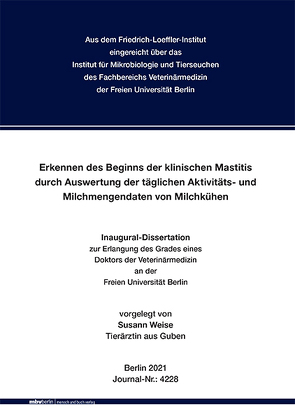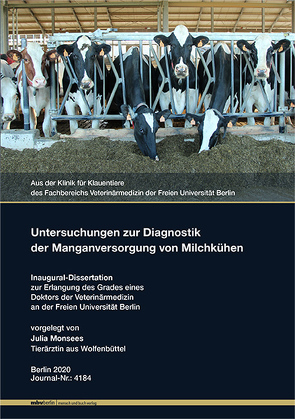
"Evaluation of transition cow management in East German dairy farms and the association between exposure length to a prepartum negative DCAD diet and health and performance in the subsequent lactation of Holstein dairy cows"
The objective of the first part of this study was to evaluate the housing and management practices in the transition period on East German dairy farms with particular focus on farms feeding a negative DCAD in the prepartum diet. Therefore, 18 farms were visited twice 2 weeks apart. We assessed (1) facility design, (2) housing system, (3) feeding management, and (4) animal health of dry cows, high pregnant heifers and fresh cows. Due to that, the stocking density were assessed in the transition groups on the 18 farms. In a subsample of cows (≥ 12) from each farm we evaluated urinary pH, net acid excretion, urinary calcium and blood NEFA, calcium and BHB. For monitoring the feeding management we analyzed the TMR regarding the ingredients, the consistency and mix quality, the sorting of TMR by dairy cows as well as the dry matter intake in the transition groups. Furthermore, a time lapse camera was installed for one week in the close-up pen and the fresh pen to evaluate the feed bunk management. The present study revealed that transition cow management might be improved on the 18 farms enrolled. Particular, monitoring of urinary pH on a weekly basis to control acidification in prepartum cows was adopted only on 2 of 18 dairy farms. The lack of regular monitoring of urinary pH led to a strong variation in urinary pH, net acid excretion and calcium levels. In only 6 of 18 herds, the average urinary pH was within the target range of 5.8 to 7.0 at both sampling times. Urinary pH was varying within the 12 cows sampled at one day, but also across the two farm visits.
In addition, more than 50% of the investigated close-up groups were overcrowded, which meant that the animals did not have an adequate supply of feeding space, water locations and resting space. The evaluations of the time lapse cameras showed that the animals in the transition groups did not have permanent access to feed and that the duration of feed deprivation was quite long. Only in few close-up and fresh groups could (1/18 and 2/13) ensure that the cows did have permanent access to feed. Moreover, the supply with water troughs was insufficient in 75 % of the transition groups (43/57). The resulting competition for feed, water, and resting space may lead to increased stress levels and have negative effects especially for submissive, smaller and younger heifers and cows on their health and performance. In 16 farms, the calving pens represented groups of 2 to 15 cows. In addition, in 6 farms, apart from the move to the calving pen, regroupings during the close-up period (≈1 to 10 days a.p.) was firmly established in the transition cow management. These can result in reduced dry matter intake, lying time, as well as milk production due to the associated stress.
The prevalence of hypocalcemia (< 2.0 mmol/L) and subclinical ketosis (BHB > 1.2 mmol/L) was 32.8 % (63/192) and 38.4% (89/232) in 18 dairy herds. In 4 of 18 herds, the prevalence of hypocalcemic cows was classified as problematic (> 41.7 %).
The increased prevalence of subclinical ketosis in the studied herds (38.4 %) is higher than reported in the international literature.
These results show that feeding of anionic diets in the close-up group in order to improve peripartum calcium homeostasis requires appropriate management, especially in the context of facility design and feeding management. Feeding of a negative DCAD diet can be conducted successfully, if urinary pH is assessed routinely, based on a weekly subsample of cows. Herd management is also considered to be of great importance in order to decrease susceptibility to ketosis (e.g., permanent access to feed; minimizing the social and environmental stress). Moreover, dry matter intake must be evaluated regularly to control for sufficient energy intake. The present study shows that there is a need for optimization regarding of transition cow management in Eastern German dairy farms feeding a negative DCAD diet in the close-up group.
The objective of the second part of this study was to evaluate the association between the exposure length to a prepartum negative DCAD diet and milk yield, milk components, reproductive performance and culling risk in the subsequent lactation. During the observation period 20,373 cows were calving on the participating 18 farms. A total of 13,314 animals (3,871 heifers and 9,443 cows) were included in the final statistical analysis. We observed considerable variation of exposure length to negative DCAD diet among farms. For primiparous cows, there was a linear association between days in the close-up group (DINCU) and milk yield at first test day (P < 0.001). An exposure length of 35 to 36 days to a negative DCAD diet was associated with the highest milk yield at first test day (35.45 kg/day; 35.43 kg/day). Primiparous cows with 35 DINCU had 3,47 kg higher milk yield at first test day than primiparous cows with 7 DINCU. Multiparous cows with 26 DINCU had the highest milk yield at firs test day (41.64 kg ± 0.33 SEM). Multiparous cows with 26 DINCU had 2,9 kg higher milk yield at first test day than multiparous cows with 7 DINCU. A plateau in milk yield was observed between 22 and 29 DINCU. Beyond 29 DINCU, however, was associated with a mild decrease in milk yield at first test day of multiparous cows. In the present study a linear association (P < 0.001) between DINCU and the ratio of fat and protein at first test day in multiparous cows was observed. The ratio of fat and protein increased slightly with extended DINCU. In 3 previous studies, did not detect a significant effect of DINCU on fat and protein content in milk (Weich et al., 2013, Wu et al., 2014, Lopera et al., 2018). There was a significant association between DINCU and somatic cell count at first test day in primiparous (P = 0.005) and multiparous cows (P = 0.011). The longer cows stayed in the close-up group, the higher was the linear score at first test.
In the present study, there was no significant association between DINCU and the risk of stillbirth for either primiparous or multiparous cows. DINCU had a significant effect on culling within the first 60 days in milk for multiparous cows (P = 0.025). Multiparous cows with 1 to 6 DINCU had the greatest hazard of being culled within the first 60 days in milk.
There was no significant association between DINCU and days open within the first 150 days in milk for either primiparous or multiparous cows.
A short stay in the close-up group should be avoided to improve milk yield at first test day and to minimize culling risk for multiparous cows. In addition, a long exposure length to negative DCAD diet (>30 d) was associated with detrimental effects on milk production and milk components in multiparous cows and linear score of primiparous and multiparous cows.
Accordingly, for multiparous cows, an exposure length of 22 to 29 days to a negative DCAD diet in the close-up group can be considered as optimal. For heifers, there is a linear association between the DINCU and milk yield in first test day. For both, cows and heifers, DINCU of < 7 days should be avoided.
Aktualisiert: 2023-02-16
> findR *

Detection of the start of clinical mastitis by analysing daily activity and milk yield data in dairy cows
Mastitis is the disease with the highest economic impact in dairy production. As it is a multifactorial disease, different factors influence the emergence of mastitis and the clinical occurrence can be divers. Digitalization in the dairy barn, known as precision dairy farming, has the potential to serve as a syndromic surveillance system. The detection of a beginning clinical mastitis by changes in milk yield and behavior may allow early recognition and treatment of the cow at risk.
In this study, individual milk yields and activity variables of holstein frisian dairy cows housed in freestall barns in two dairy farms (farm 1 hold 1100 and farm 2 hold 400 milking cows) were investigated for deviations of this variables in the days, before clinical mastitis was diagnosed. Documented mastitis events in the herd management software Dairy Comp305 were used to identify mastitis periods. The cows were equipped with activity sensors (IceQubes of IceRobotics LtD, South Queensferry, UK).
First, the absolute values of daily milk yields and activity values (lying time, standing time, steps, motion index and changes of standing to lying) were examined ten days before the documented mastitis event. After that, the individual relative deviation five days before mastitis was calculated for all listed variables.
Due to the indirect proportional relationship of standing time and lying time and the lack of statistical significance of changes between standing and lying concerning the development of mastitis, the number of variables were reduced to the relative deviation in milk yield, lying time and motion index. On day two before the documented mastitis, the chosen variables were significant compared to the control periods.
The relative deviations of milk yield, lying time and motion index were used to distinguish between animals with mastitis and a control group. In farm 1, a combination of cut-off points led to a sensitivity of 70 % and a specificity of 40 %. In farm 2, the sensitivity of 70 % and specificity of 63.6 % was reached.
When the effect of the lactation phase on the deviation in milk yield and the individual activity to the group activity was taken into account, it became evident that this was no meaningful advantage in distinguishing mastitis periods from a control periods by relative deviations.
So far, no comparable number of mastitis events over such a long period was used for analysing this topic. It has to be noted however, that further analyses may be necessary, which could utilize more detailed information about clinical mastitis. It will also be important to check the insights of this thesis during the daily work in dairy farms.
Aktualisiert: 2021-06-24
> findR *

Die adäquate Versorgung von Milchkühen mit Nährstoffen und insbesondere auch Spurenelementen ist für eine gesunde sowie leistungsstarke Herde von enormer Wichtigkeit. Zur Einordnung des Mn-Status einer Milchviehherde sollen in der vorliegenden Dissertation Referenzbereiche für unterschiedliche Probenmedien präsentiert werden.
Klinisch kann sich ein Mn-Mangel unter anderem durch eine verminderte Fruchtbarkeitsrate von Milchkühen oder der Geburt deformierter und lebensschwacher Kälber äußern. Zudem wird die Ansicht vertreten, dass sich das Geschlechterverhältnis zugunsten der männlichen Tiere verschiebt. Ursächlich hierfür ist nicht unbedingt ein primärer Mangel an Mn. Von großer Bedeutung sind vor allem sekundär bedingte Mangelzustände durch Mn-Antagonisten, wie Fe, das in hohen Konzentrationen im Trinkwasser vorkommen kann.
Die Resorptionsrate von Mn beträgt bei Rindern zwischen 0,5 und 5,0 %. Es wird aus dem gesamten Intestinum resorbiert. Mn befindet sich hauptsächlich in mitochondrienreichen Organen, wie der Leber, dem Knochengewebe oder den Haaren. Größtenteils wird es durch den TfR oder via DMT-1 in die Zelle aufgenommen. Die Ausscheidung erfolgt über die Leber. Wenigstens 95 % des absorbierten Mn werden so im first pass effect eliminiert, mit der Galle exkretiert und über die Fäzes ausgeschieden. Für die Aufrechterhaltung der Homöostase spielen aber vor allem die Veränderungen der Absorptionsrate eine Rolle. Durch die Bindung an Proteine, die die Filtration über die Niere verhindert, beträgt der Anteil im Urin < 1 % der Mn-Aufnahme.
Die in dieser Arbeit präsentierten Ergebnisse basieren auf der Auswertung von Daten aus
der Bestandsbetreuung der Klinik für Klauentiere, FU Berlin. Sie werden in zwei Studien
unterteilt.
Die Datei der Bestandsuntersuchung umfasst Erhebungen aus 564 Milchviehbetrieben der Jahre 2007 bis 2014. Die durchschnittliche Tierzahl betrug 495 Tiere pro Betrieb. Größtenteils gehörten sie den Rassen Holstein Friesian und Schwarzbuntes Milchrind an. Die Kühe wurden zumeist in Boxenlaufställen gehalten und bekamen eine TMR gefüttert. Pro Laktationsgruppe wurden zehn klinisch gesunde, vorzugsweise pluripare Tiere ausgewählt und beprobt. Die Mn-Konzentration wurde in folgenden Substraten bestimmt: Blutserum, EDTA-Plasma, EDTA-Vollblut, Harn und Haar.
In die Datei der Betriebsuntersuchung flossen Untersuchungen aus dem Winter 2007/2008 ein. Sie stammen aus einem milchproduzierenden Landwirtschaftsbetrieb mit zu dem Zeitpunkt etwa 1400 Kühen der Rasse Holstein Friesian. Auch hier wurden aus jeder Laktationsgruppe jeweils zehn klinisch gesunde, pluripare Tiere ausgewählt und folgende Probenmedien entnommen: Blutserum, EDTA-Plasma, EDTA-Vollblut, Haar und Lebergewebe.
Die Proben wurden mit der ICP-OES Methode spektrometrisch untersucht. In allen Substraten lagen die erhobenen Mn-Werte im niedrigen Konzentrationsbereich. Es zeigten sich trotzdem keine klinischen Hinweise auf eine mangelhafte Versorgungslage. Unter üblichen Haltungs- und Fütterungsbedingungen ist ein Mn-Mangel somit nicht zu erwarten.
Nachdem die erhobenen Daten log-transformiert wurden, konnten zu ihrer weitergehenden Auswertung parametrische Testverfahren angewandt werden.
In der Betriebsdatei bestehen für die Mn-Konzentration mittlere Korrelationen zwischen den Plasma- und Serum- sowie den Plasma- und Vollblutwerten. In der Bestandsdatei wurde ein Zusammenhang zwischen den Serum-Mn-Werten zu den Mn-Konzentration in folgenden Proben nachgewiesen: Plasma, Vollblut und Leber.
Bei den unterschiedlichen Spurenelementgehalten im Serum bestehen ein positiver Zusammenhang zwischen denen von Mn und Zn sowie ein negativer Zusammenhang der Mn-Werte zu denen von Fe.
Der Zusammenhang der Serumkonzentration des an der Knorpelsynthese beteiligten Cholesterol zur Serum-Mn-Konzentration konnte ebenfalls bestätigt werden.
Bundesland und Herdengröße hatten in dieser Studie keinen nachweislichen Einfluss auf den Mn-Status einer Milchvieherde.
Die Mn-Mittelwerte in den verschiedenen Blutmedien stiegen im Laktationsverlauf an und unterscheiden sich signifikant voneinander. Auch jahreszeitliche Schwankungen konnten nachgewiesen werden. Dementsprechend bestanden ebenfalls signifikante Unterschiede in der Serum-Mn-Konzentration bezüglich des Untersuchungsmonats und auch des Untersuchungsjahres.
Der viel diskutierte Zusammenhang zwischen der Mn-Konzentration in den verschiedenen Untersuchungsmedien und dem Verhältnis von männlichen zu weiblichen Kälbern ließ sich in der vorliegenden Auswertung nicht erkennen. Dafür zeigte sich ein signifikanter Zusammenhang zwischen der Serum- sowie der Vollblut-Mn-Konzentration und dem Besamungsindex.
Der Mn-Gehalt im Futtermittel wurde in dieser Dissertation nicht näher beleuchtet. Trotzdem scheint eine sorgfältig durchgeführte Analyse des Mn-Gehalts der vorgelegten TMR die geeignetste Methode zur Erhebung des Mn-Status einer Milchviehherde zu sein. Eine Konzentrationsbestimmung des Antagonisten Fe im Futter sowie im Wasser würde diese Methode vervollständigen.
Auch das Probenmedium Kot war kein Bestandteil der vorliegenden Arbeit. Wegen der hohen fäkalen Exkretion von Mn und der einfachen und kostengünstigen Probengewinnung ist es allerdings sinnvoll, dieses Substrat als mögliches Probenmedium zu untersuchen.
Aus den in der vorliegenden Arbeit ermittelten Mn-Konzentrationen in den verschiedenen Medien wurden Grenzwerte berechnet und mit Hilfe dieser Referenzbereiche für die einzelnen Substrate abgeleitet:
Medium: Serum
Einheit: μg/l
Empfohlener Referenzbereich: 1,0 - 3,0
Medium: Plasma
Einheit: μg/l
Empfohlener Referenzbereich: 1,4 - 8,0
Medium: EDTA-Vollblut
Einheit: μg/l
Empfohlener Referenzbereich: 5,0 - 14
Medium: Harn
Einheit: μg/l
Empfohlener Referenzbereich: 0,5 - 8,0
Medium: Haar
Einheit: mg/kg
Empfohlener Referenzbereich: 1,0 - 23
Medium: Leber
Einheit: mg/kg
Empfohlener Referenzbereich: 3,8 - 11
Aktualisiert: 2022-12-31
> findR *
MEHR ANZEIGEN
Bücher zum Thema lactation
Sie suchen ein Buch über lactation? Bei Buch findr finden Sie eine große Auswahl Bücher zum
Thema lactation. Entdecken Sie neue Bücher oder Klassiker für Sie selbst oder zum Verschenken. Buch findr
hat zahlreiche Bücher zum Thema lactation im Sortiment. Nehmen Sie sich Zeit zum Stöbern und finden Sie das
passende Buch für Ihr Lesevergnügen. Stöbern Sie durch unser Angebot und finden Sie aus unserer großen Auswahl das
Buch, das Ihnen zusagt. Bei Buch findr finden Sie Romane, Ratgeber, wissenschaftliche und populärwissenschaftliche
Bücher uvm. Bestellen Sie Ihr Buch zum Thema lactation einfach online und lassen Sie es sich bequem nach
Hause schicken. Wir wünschen Ihnen schöne und entspannte Lesemomente mit Ihrem Buch.
lactation - Große Auswahl Bücher bei Buch findr
Bei uns finden Sie Bücher beliebter Autoren, Neuerscheinungen, Bestseller genauso wie alte Schätze. Bücher zum
Thema lactation, die Ihre Fantasie anregen und Bücher, die Sie weiterbilden und Ihnen wissenschaftliche
Fakten vermitteln. Ganz nach Ihrem Geschmack ist das passende Buch für Sie dabei. Finden Sie eine große Auswahl
Bücher verschiedenster Genres, Verlage, Autoren bei Buchfindr:
Sie haben viele Möglichkeiten bei Buch findr die passenden Bücher für Ihr Lesevergnügen zu entdecken. Nutzen Sie
unsere Suchfunktionen, um zu stöbern und für Sie interessante Bücher in den unterschiedlichen Genres und Kategorien
zu finden. Unter lactation und weitere Themen und Kategorien finden Sie schnell und einfach eine Auflistung
thematisch passender Bücher. Probieren Sie es aus, legen Sie jetzt los! Ihrem Lesevergnügen steht nichts im Wege.
Nutzen Sie die Vorteile Ihre Bücher online zu kaufen und bekommen Sie die bestellten Bücher schnell und bequem
zugestellt. Nehmen Sie sich die Zeit, online die Bücher Ihrer Wahl anzulesen, Buchempfehlungen und Rezensionen zu
studieren, Informationen zu Autoren zu lesen. Viel Spaß beim Lesen wünscht Ihnen das Team von Buchfindr.


